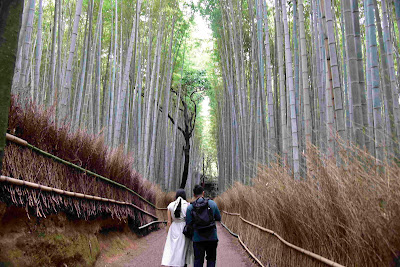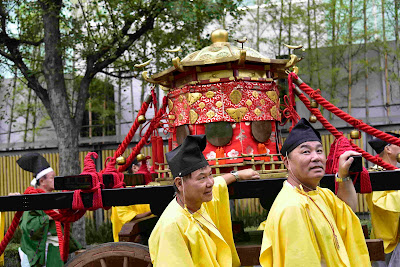Our second day in Kyoto was so full we took a few days to get the text and photos together.
In its earliest development, Japan copied Chinese and Korean cultures. Buddhism also was brought from India.
This is the original steam engine that Commodore Perry delivered to the Emperor of Japan who decided that it was essential to modernize their transportation system.
Before the railroads, merchants could not, by law, own pack animals so all goods had to be carried from place to place on foot.
Our first feature of this tour was the Bamboo Forest which is in the middle of the city. It continues to provide tranquility to those who visit. The roots grow fast and can be invasive. The practice of being in the forest known as “forest bathing” or deep contemplation continues today.
Cremation is the common burial practice. Beneath this stone rest the ashes of up to seven generations of males. We asked what happens after seven generations but, since that time has not passed, there is no answer.
In Shintoism, all of nature has a spirit. A special deity resides in mountains, waterfalls, etc. The religion emphasizes convenience, simplicity and order.These priests in yellow robes are celebrating a harvest festival.The Gold Pavilion is at the Kinkaku site. This is a World Heritage Site and was built by an obviously wealthy individual. It is actually covered in gold leaf which is reapplied every thirty years. It was applied last year so the gold really looked good. This is a holiday villa for shoguns. A phoenix sits on top.We were riding a bus to our next stop when we came upon a parade of Shintos walking and carrying floats to their temple in honor of a harvest festival. There was also a horse drawn carriage carrying nobles.This was our 2pm lunch stop.We saw many geishas along our walk. They started in tea houses 500 years ago. Contrary to popular beliefs the original geisha were men, mainly jesters. The women were geico. Today women go through several years of training to become geishas. Their job is to provide music, luxury meals, drinks and entertainment for the men.
One of our neighbors recommended that to go to Arashiyama, a district that has many traditional sites. This photo is of our excellent guide.
The tubes along the way contain the patterns of traditional garb.
We signed up for a walking tour but did not suspect that the total walking for the day would total 18 km in addition to bus and train rides. We were happy to get back to our hotel for a night’s rest.
Our guide for the day was outstanding. Beyond all he taught us, he helped in additional things we were interested in. At the end of this long day, we felt as if we had a new, special friend.




















No comments:
Post a Comment